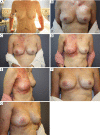Prepectoral breast reconstruction and radiotherapy-a closer look
- PMID: 30842930
- PMCID: PMC6378256
- DOI: 10.21037/gs.2019.01.01
Prepectoral breast reconstruction and radiotherapy-a closer look
Abstract
Background: Prosthetic breast reconstruction in the setting of post-mastectomy radiation therapy (PMRT) has historically been plagued by complications and poor outcomes. We study the effects of PMRT in the setting of prepectoral prosthetic breast reconstruction in an attempt to ascertain the value of this muscle sparing technique as it relates to complications and outcomes.
Methods: A retrospective analysis was performed on patients who underwent immediate, prepectoral, direct-to-implant or two-staged expander/implant breast reconstruction following skin-sparing mastectomy (SSM) or nipple-sparing mastectomy (NSM) and had postmastectomy radiotherapy. Results and complications were recorded.
Results: In patients who underwent two-staged reconstruction, at the second stage, on visual inspection, the acellular dermal matrix was noted to be completely integrated in all breasts, including those that had been irradiated after expander placement. Postoperative complications in irradiated breasts were limited to two breasts. In one breast, there was one incidence of wound dehiscence after expander irradiation, which led to expander removal and salvage with transverse rectus abdominis musculocutaneous (TRAM) flap reconstruction. In the second breast, there was one incidence of seroma after implant irradiation, which was managed conservatively as an outpatient. The seroma was drained and the patient treated with oral antibiotics. There were no complications in nonirradiated breasts. There was no incidence of clinically significant capsular contracture (grade III/IV) in irradiated or nonirradiated breasts.
Conclusions: Prepectoral breast reconstruction has been an important addition to our reconstructive armamentarium and is proving to be a safe and effective means of performing prosthetic breast reconstruction in a wide array of patient populations. We have seen excellent physiologic and aesthetic outcomes in our patients following PMRT with minimal complications. Indeed, long-term follow-up will be required to elucidate the true effectiveness of this technique but preliminary results are quite promising.
Keywords: Prepectoral breast reconstruction; breast reconstruction; post-mastectomy radiation; prosthetic breast reconstruction; radiotherapy; tissue expander-based breast reconstruction.
Conflict of interest statement
Conflicts of Interest: The author has no conflicts of interest to declare.
Figures


References
-
- American Society of Plastic surgeons. 2016 Plastic Surgery Statistics Report. Available online: https://www.plasticsurgery.org/documents/News/Statistics/2016/plastic-su...
LinkOut - more resources
Full Text Sources
Medical
